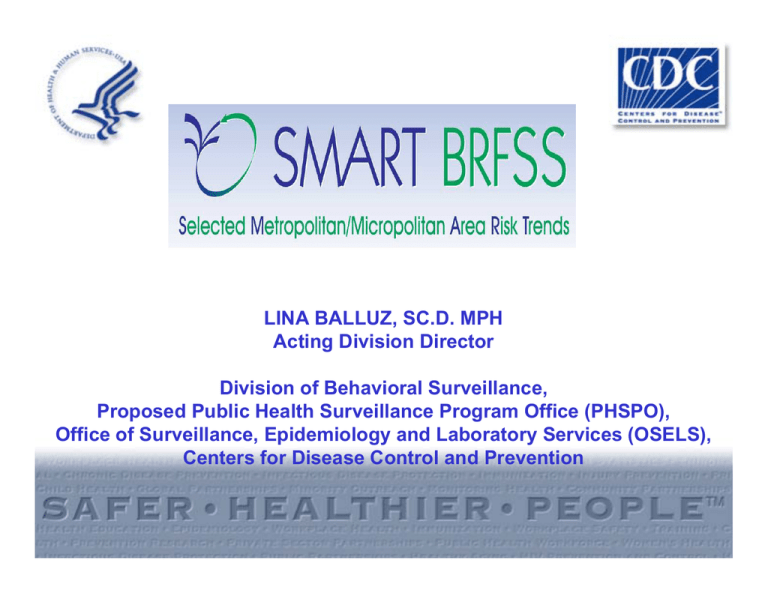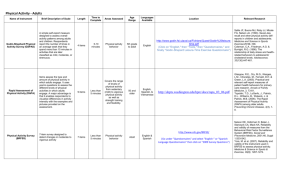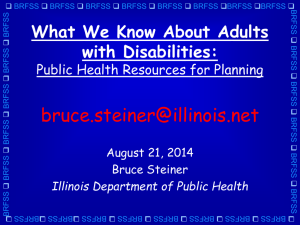LINA BALLUZ, SC.D. MPH Acting Division Director Division of Behavioral Surveillance,
advertisement

LINA BALLUZ, SC.D. MPH Acting Division Director Division of Behavioral Surveillance, Proposed Public Health Surveillance Program Office (PHSPO), Office of Surveillance, Epidemiology and Laboratory Services (OSELS), Centers for Disease Control and Prevention BRFSS History • State-based system in collaboration with CDC • Established in 1984 with 15 states • Began with six individual-level risk factors associated with leading causes of premature mortality among adults • Cigarette smoking; Alcohol use; Physical inactivity; Diet; Hypertension; Safety belt use Current BRFSS • Conducted by all 50 states, DC, Puerto Rico, U.S. Virgin Islands, and Guam • Largest continuously conducted telephone health survey in the world • More than 414,000 interviews in 2009 • More than 4 millions interviews overall • Primary focus on adult behaviors linked with leading causes of morbidity and mortality Genesis of Project • Demand for local data • Increased sample size • Analysis of smaller areas possible • Metropolitan/ Micropolitan statistical areas (MMSAs) • Counties MMSAs??? • Metropolitan Statistical Area – Group of counties with 50,000 or more • Metropolitan Division – Group of counties within metropolitan statistical area of 2.5 million or more • Micropolitan Statistical Area – Group of counties between 10,000 and 50,000 SMART BRFSS was born!!! • Selected • Metropolitan/Micropolitan • Area • Risk • Trends Criteria needed to included in SMART • MMSA with at least 500 completed interviews • Counties with at least 250 completed interviews Data analysis • MMSA and county specific estimates • Statistical package that accounts for complex design • State weights are adjusted to produce MMSA and county level weights • Weighting classes are based on age, gender and race. Action • Identify emerging health problems • Program development • Policy development • Tracking health risk trends • Program evaluation MMSA Prevalence (%) of Selected Health Indicators, 2008 Lowest Highest Obesity 14.8 (Boulder, CO) 38.7 (Orangeburg, SC) Smoking 4.9 (Provo-Orem, UT) 30.9 (Wichita Fall, TX) No Physical Activity 12.3 (Boulder, CO) 40.1 (Wichita Falls, TX) Binge Drinking 2.9 (Provo-Orem, UT)) 25.1 (Norfolk, NE) Diabetes 2.8 (Bozeman, MT) 16.7 (Huntington-Ashland, WVKY-OH) CHD or Angina 2.0 (Boulder, CO) 9.0 (Charleston, WV) Hypertension N/A N/A County Prevalence (%) of Selected Health Indicators, 2008 Lowest Highest Obesity 11.7 (Summit Co , UT) 40.9 (Laurens Co, SC) Smoking 4.7 (Utah Co, UT) 30.2 (St. Louis City, MO) No Physical Activity 9.8 (Douglas Co, CO) 40.1 (Hinds Co, MS) Binge Drinking 2.9 (Utah Co, UT) 25.4 (Pinal Co, AZ) Diabetes 2.7 (Summit Co) 13.8 (Jefferson Co, AL) CHD or Angina 0.8 (Franklin Co, MA) 9.8 (Kanawha Co, WV) Hypertension N/A N/A SMART BRFSS in Fargo • Fargo, ND – 22.3% binge drinking vs. 15.5% nationwide • Formed community coalition: AMP (Alcohol Misuse Prevention) • Mission: Reduce alcohol use among those under 21 in the Fargo-Moorhead area. – Anti-binge drinking campaign – Policy change sanctioning facilities Local BRFSS Data Impact • Williamson County, Texas — 56% no physical activity, 34% overweight, and 21% obese • Local public health officials took notice — and ACTION • Created bicycle maps with routes, roadway ratings, safety tips • Developed Web-based application for customized maps Progression • SMART 2002 (BRFSS Sample size=250,121) – • SMART 2003 (BRFSS Sample size= 264,684) – • 145 MMSAs, 234 counties for all years SMART 2007 (BRFSS Sample size= 430,912) – • 153 MMSAs; 232 counties SMART 2006 (BRFSS Sample size= 355,710) • • 134 MMSAs; 199 counties SMART 2005 ((BRFSS Sample size= 356,112) – • 105 MMSAs; 153 counties SMART 2004 (BRFSS Sample size= 303,822) – • 98 MMSAs ,146 counties 184 MMSA, 298 counties SMART 2008 (BRFSS Sample size= 415,526) – 177 MMSA, 266 counties Issues • Two situations in local areas: • Previously had data • Local data for first time • Worked with BRFSS state coordinators • Worked with National Association of County and City Health Officials (NACCHO) • Develop a plan of action Plan of Action • Data dissemination • Contact local health officials • Contact national partner organizations • Develop a Web site Working with NACCHO • Database of local health officials • Getting the word out to members • Conducted regional conference calls – BSB representatives and BRFSS state coordinators – Invited all impacted local health officials; representatives from national partner organizations • Calls with partners (CSTE, CDD, APHA) Communication • Opportunity for feedback and questions • Briefed other CDC folks • Mailed out over 1200 packets of information • Worked with APHA for public announcement Initial Release • Started in 2002 but initial release November 2003 • Progression – SMART 2003 release (April 2004) • SMART 2004 release (September 2005) – SMART 2005 release (September 2006) SMART Web Site • Best way to reach our audience • Set-up Web site in similar format to existing BRFSS site • Included new features and dimensions • Quick-View Charts • Displaying counties and MMSAs • Selected variables BRFSS Challenges Telephone coverage Increase in cell phone usage Negative impact of telemarketers Increasing number of questions Rising demand for state and local level data SAFER . HEALTHIER . PEOPLE BRFSS Strengths Standardized − Allows state-to-state comparisons Flexible − Addition of questions to address relevant topics Timely − Address urgent and emerging health issues Longevity − Bank of archived questions Essential and unique SAFER . HEALTHIER . PEOPLE 2010 BRFSS • Cell phone • Mail survey • Physical measure




